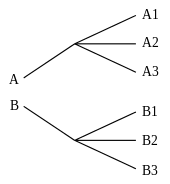Rule of product
In combinatorics, the rule of product or multiplication principle is a basic counting principle (a.k.a. the fundamental principle of counting). Stated simply, it is the idea that if there are a ways of doing something and b ways of doing another thing, then there are a · b ways of performing both actions.[1][2]

Examples
In this example, the rule says: multiply 3 by 2, getting 6.
The sets {A, B, C} and {X, Y} in this example are disjoint sets, but that is not necessary. The number of ways to choose a member of {A, B, C}, and then to do so again, in effect choosing an ordered pair each of whose components are in {A, B, C}, is 3 × 3 = 9.
As another example, when you decide to order pizza, you must first choose the type of crust: thin or deep dish (2 choices). Next, you choose one topping: cheese, pepperoni, or sausage (3 choices).
Using the rule of product, you know that there are 2 × 3 = 6 possible combinations of ordering a pizza.
Applications
In set theory, this multiplication principle is often taken to be the definition of the product of cardinal numbers.[1] We have
where is the Cartesian product operator. These sets need not be finite, nor is it necessary to have only finitely many factors in the product; see cardinal number.
Related concepts
The rule of sum is another basic counting principle. Stated simply, it is the idea that if we have a ways of doing something and b ways of doing another thing and we can not do both at the same time, then there are a + b ways to choose one of the actions.[3]
See also
References
- Johnston, William, and Alex McAllister. A transition to advanced mathematics. Oxford Univ. Press, 2009. Section 5.1
- "College Algebra Tutorial 55: Fundamental Counting Principle". Retrieved December 20, 2014.
- Rosen, Kenneth H., ed. Handbook of discrete and combinatorial mathematics. CRC pres, 1999.